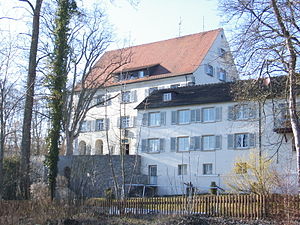Gaienhofen Castle
| Gaienhofen Castle | ||
|---|---|---|
|
Gaienhofen Castle |
||
| Creation time : | until 1110 | |
| Castle type : | Niederungsburg | |
| Conservation status: | Received or received substantial parts | |
| Standing position : | clergy | |
| Place: | Gaienhofen | |
| Geographical location | 47 ° 40 '46.8 " N , 8 ° 58' 53" E | |
|
|
||
The Gaienhofen Castle is a late medieval castle in Gaienhofen in the district of Konstanz in Baden-Wuerttemberg . From 1946 to 2013 it housed a boarding school , today the school center Schloss Gaienhofen - Protestant school on Lake Constance .
location
The castle was on the peninsula Höri in riparian location on Lake Constance built. The location was chosen strategically right on the Untersee , where the Rhine expands towards Lake Constance.
history
The castle was built for the Bishop of Constance Gebhard III. von Zähringen (1085–1110) built as a hunting property. A documentary mention comes from the year 1295, when Albrecht von Klingenberg , imperial bailiff in Constance, handed over the castle and village with the bailiwick and other possessions to his brother Bishop Heinrich II . At that time the castle, like most of the nearby ones, was owned by the Lords of Klingenberg . In 1311 Albrecht von Klingenberg sold it to the Diocese of Constance , which it often pledged into the 16th century. In the 15th century the castle became the seat of episcopal bailiffs and chief bailiffs. The rule was pledged to Bishop Konrad von Freisingen , von Klingenberg, von Reischach and von Heuberg, among others .
Konrad von Reischach and Isabella, daughter of King Jacob III, resided at Gaienhofen Castle since 1412 . from Mallorca , was married. A son, Michael, was born from the marriage with the king's daughter. In connection with the Council of Constance (1414–1418), father and son held a festival at Gaienhofen Castle. Following this festival, Michael was murdered by two guests, Heinrich von Randegg and Hans von Stuben , for an unknown reason around the ninth hour of the night on St. Bartholomew's 1417 on the stairs of the castle. His father died a year later with no offspring.
The castle was the scene of acts of war on several occasions. In 1499 it was occupied by the Swiss during the Swiss War. In the Peasants 'War of 1524/25 it was rebellious peasants and in the Thirty Years' War (1618-48) Swedish troops who held the castle and plundered the surrounding area. In 1632 a naval battle between the imperial and Swedes took place in front of the castle walls (see Naval War on Lake Constance 1632–1648 ).
Around 1700, the castle was expanded into a baroque palace under Prince-Bishop Marquard Rudolf von Rodt (1689–1704). The castle was called "Castle of the Nine Towers", of which only eight could be located. Due to the secularization , the castle fell to the margraviate of Baden in 1803 . In 1821 it was bought by the Baden captain Wilhelm Reinhard von Weiterdingen. In 1854 the last tower was demolished.
In 1903, Gaienhofen Castle was leased to Georg von Petersenn , professor at the Berlin School of Music. The Deutsche Landerziehungsheim für Mädchen (DLEHfM) founded in Stolpe am Wannsee in 1900 , the concept of which is based on the principles of the reform pedagogue Hermann Lietz , was relocated to Gaienhofen in 1904. The foundation by Bertha von Petersenn was based on the idea of empowering girls to become self-employed and to work through varied training. The DLEHfM was headed by their daughter Jutta von Petersenn. In 1906 Georg von Petersenn bought the castle and in 1911 his daughter Hermann Lietz married. Under the direction of Alfred Andreesen , the relationship between the DLEHfM and the educational home for girls in Gaienhofen waned. On June 8, 1925, there was a serious fire in the castle. The burned-out country education home was then rebuilt and continued until 1944 after it was sold to Elisabeth Müller from Flensburg. It was not until 1933 that the first boy was admitted to the boarding school, which had previously only been attended by girls. In the chaos of the Second World War , there were no regular school lessons.
In 1946, a year after the end of the war, efforts by the Konstanz pastor Hermann Senges and the Konstanz dean Friedrich Mono asked the school association of the Evangelical Boarding School (today the school foundation of the Evangelical Regional Church in Baden ) to take over responsibility for the boarding school - the Evangelical boarding school Schloss Gaienhofen was founded. In 1952 the Evangelical Church bought the castle. The castle, which had been modified several times for this purpose and new buildings were added, served the Protestant boarding school as a boarding house for girls. The boarding school was closed in the summer of 2013.
Todays use
There are multifunctional rooms in the castle that are used by the school and its administration.
Gaienhofen Castle and the bank section are not open to the public.
literature
- Max Miller , Gerhard Taddey (ed.): Handbook of the historical sites of Germany . Volume 6: Baden-Württemberg (= Kröner's pocket edition . Volume 276). 2nd, improved and enlarged edition. Kröner, Stuttgart 1980, ISBN 3-520-27602-X .
- Michael Losse, Ilga Koch: Palaces and castles on western Lake Constance (Hegau Library; 122). Wartberg-Verlag, Gudensberg-Gleichen 2004, ISBN 3-8313-1448-9 .
- Udo Beenken (ed.), Evangelical boarding school Gaienhofen (ed.): Schloss-Schule Gaienhofen. Protestant boarding school 1946-1986 . Verlag Stadler, Konstanz 1986. ISBN 3-7977-0154-3 .
Web links
Individual evidence
- ↑ Media release from the school management ( memento of the original from September 24, 2015 in the Internet Archive ) Info: The archive link was inserted automatically and has not yet been checked. Please check the original and archive link according to the instructions and then remove this notice. (PDF; 65 kB)


